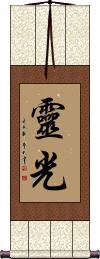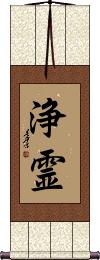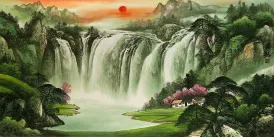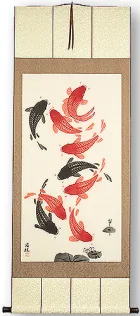Many custom options...
And formats...

Light of Heaven in Chinese / Japanese...
Buy a Light of Heaven calligraphy wall scroll here!
Personalize your custom “Light of Heaven” project by clicking the button next to your favorite “Light of Heaven” title below...
Divine Light
Johrei / Jyorei
Jyorei or Johrei is a healing art that uses divine light to dissolve the spiritual impurities that are the source of all physical, emotional, and personal problems.
浄霊/浄靈 is a Japanese title that can refer to the purification of the spirit described above, but this is also the word for exorcism in Japanese.
Romanization variations include Jyorei, Johrei, Jourei and Jore. Regardless of romanization, the actual pronunciation is like "Joe Ray."
This in-stock artwork might be what you are looking for, and ships right away...
Gallery Price: $200.00
Your Price: $79.88
Gallery Price: $126.00
Your Price: $69.88
Gallery Price: $126.00
Your Price: $69.88
Gallery Price: $400.00
Your Price: $138.88
Gallery Price: $220.00
Your Price: $138.88
Gallery Price: $120.00
Your Price: $79.88
Gallery Price: $72.00
Your Price: $39.95
Not the results for light of heaven that you were looking for?
Below are some entries from our dictionary that may match your light of heaven search...
| Characters If shown, 2nd row is Simp. Chinese |
Pronunciation Romanization |
Simple Dictionary Definition |
靈光 灵光 see styles |
líng guāng ling2 guang1 ling kuang |
More info & calligraphy: Divine Light |
十二 see styles |
shí èr shi2 er4 shih erh tooji とおじ |
twelve; 12 12; twelve; (given name) Tooji dvātriṃśa. Thirty-two. 三十二應 (or 三十二身) The thirty-two forms of Guanyin, and of Puxian, ranging from that of a Buddha to that of a man, a maid, a rakṣas; similar to the thirty-three forms named in the Lotus Sūtra. 三十二相三十二大人相 dvātriṃśadvaralakṣaṇa. The thirty-two lakṣaṇas, or physical marks of a cakravartī, or 'wheel-king', especially of the Buddha, i. e. level feet, thousand-spoke wheel-sign on feet, long slender fingers, pliant hands and feet, toes and fingers finely webbed, full-sized heels, arched insteps, thighs like a royal stag, hands reaching below the knees well-retracted male organ, height and stretch of arms equal, every hair-root dark coloured, body hair graceful and curly, golden-hued body, a 10 ft. halo around him, soft smooth skin, the 七處, i. e. two soles, two palms, two shoulders, and crown well rounded, below the armpits well-filled, lion-shaped body, erect, full shoulders, forty teeth, teeth white even and close, the four canine teeth pure white, lion-jawed, saliva improving the taste of all food, tongue long and broad, voice deep and resonant, eyes deep blue, eyelashes like a royal bull, a white ūrnā or curl between the eyebrows emitting light, an uṣṇīṣa or fleshy protuberance on the crown. These are from the 三藏法數 48, with which the 智度論 4, 涅盤經 28, 中阿含經, 三十ニ相經 generally agree. The 無量義經 has a different list. 三十二相經 The eleventh chapter of the 阿含經. 三十二相經願 The twenty-first of Amitābha's vows, v. 無量壽經. 三十三 trayastriṃśat. Thirty-three. 三十三天忉利天; 憺梨天, 多羅夜登陵舍; 憺利夜登陵奢; 憺利耶憺利奢 Trayastriṃśas. The Indra heaven, the second of the six heavens of form. Its capital is situated on the summit of Mt. Sumeru, where Indra rules over his thirty-two devas, who reside on thirty-two peaks of Sumeru, eight in each of the four directons. Indra's capital is called 殊勝 Sudarśana, 喜見城 Joy-view city. Its people are a yojana in height, each one's clothing weighs 六鐵 (1; 4 oz. ), and they live 1, 000 years, a day and night being equal to 100 earthly years. Eitel says Indra's heaven 'tallies in all its details with the Svarga of Brahminic mythology' and suggests that 'the whole myth may have an astronomical meaning', or be connected, with 'the atmosphere with its phenomena, which strengthens Koeppen's hypothesis explaining the number thirty-three as referring to the eight Vasus, eleven Rudras, twelve Ādityas, and two Aśvins of Vedic mythology'. In his palace called Vaijayanta 'Indra is enthroned with 1, 000 eyes with four arms grasping the vajra. There he revels in numberless sensual pleasures together with his wife Śacī... and with 119, 000 concubines with whom he associates by means of transformation'.; dvādaśa, twelve. |
四禪 四禅 see styles |
sì chán si4 chan2 ssu ch`an ssu chan shizen |
(四禪天) The four dhyāna heavens, 四靜慮 (四靜慮天), i. e. the division of the eighteen brahmalokas into four dhyānas: the disciple attains to one of these heavens according to the dhyāna he observes: (1) 初禪天 The first region, 'as large as one whole universe' comprises the three heavens, Brahma-pāriṣadya, Brahma-purohita, and Mahābrahma, 梵輔, 梵衆, and 大梵天; the inhabitants are without gustatory or olfactory organs, not needing food, but possess the other four of the six organs. (2) 二禪天 The second region, equal to 'a small chiliocosmos' 小千界, comprises the three heavens, according to Eitel, 'Parīttābha, Apramāṇābha, and Ābhāsvara, ' i. e. 少光 minor light, 無量光 infinite light, and 極光淨 utmost light purity; the inhabitants have ceased to require the five physical organs, possessing only the organ of mind. (3) 三禪天 The third region, equal to 'a middling chiliocosmos '中千界, comprises three heavens; Eitel gives them as Parīttaśubha, Apramāṇaśubha, and Śubhakṛtsna, i. e. 少淨 minor purity, 無量淨 infinite purity, and 徧淨 universal purity; the inhabitants still have the organ of mind and are receptive of great joy. (4) 四禪天 The fourth region, equal to a great chiliocosmos, 大千界, comprises the remaining nine brahmalokas, namely, Puṇyaprasava, Anabhraka, Bṛhatphala, Asañjñisattva, Avṛha, Atapa, Sudṛśa, Sudarśana, and Akaniṣṭha (Eitel). The Chinese titles are 福生 felicitous birth, 無雲 cloudless, 廣果 large fruitage, 無煩 no vexations, atapa is 無熱 no heat, sudṛśa is 善見 beautiful to see, sudarśana is 善現 beautiful appearing, two others are 色究竟 the end of form, and 無想天 the heaven above thought, but it is difficult to trace avṛha and akaniṣṭha; the inhabitants of this fourth region still have mind. The number of the dhyāna heavens differs; the Sarvāstivādins say 16, the 經 or Sutra school 17, and the Sthavirāḥ school 18. Eitel points out that the first dhyāna has one world with one moon, one mem, four continents, and six devalokas; the second dhyāna has 1, 000 times the worlds of the first; the third has 1, 000 times the worlds of the second; the fourth dhyāna has 1, 000 times those of the third. Within a kalpa of destruction 壞劫 the first is destroyed fifty-six times by fire, the second seven by water, the third once by wind, the fourth 'corresponding to a state of absolute indifference' remains 'untouched' by all the other evolutions; when 'fate (天命) comes to an end then the fourth dhyāna may come to an end too, but not sooner'. |
廅天 see styles |
hé tiān he2 tian1 ho t`ien ho tien ōten |
Parīttābha, the fourth brahmaloka, the first region of the second dhyāna. |
神光 see styles |
shén guāng shen2 guang1 shen kuang jinkou / jinko じんこう |
(surname) Jinkou deva-light, the light of the gods. |
羽化 see styles |
yǔ huà yu3 hua4 yü hua uka うか |
levitation (of Daoist immortal); to become as light as a feather and ascend to heaven; (in Daoism) to become immortal; to die; of winged insects, to emerge from the cocoon in adult form; eclosion (n,vs,vi) {zool} emergence (of insects); eclosion; growing wings; (surname) Uka |
光音天 see styles |
guāng yīn tiān guang1 yin1 tian1 kuang yin t`ien kuang yin tien kōon ten |
Ābhāsvara, light and sound, or light-sound heavens, also styled 極光淨天, the heavens of utmost light and purity, i. e. the third of the second dhyāna heavens, in which the inhabitants converse by light instead of words; they recreate the universe from the hells up to and including the first dhyāna heavens after it has been destroyed by fire during he final series of cataclysms; but they gradually diminish in power and are reborn in lower states. The three heavens of the second dhyāna are 少光, 無量光, and 光音. |
化樂天 化乐天 see styles |
huà lè tiān hua4 le4 tian1 hua le t`ien hua le tien keraku ten |
Nirmāṇarati, 樂變化天 the fifth of the six desire-heavens, 640, 000 yojanas above Meru; it is next above the Tuṣita, or fourth deva. loka; a day is equal to 800 human years; life lasts for 8, 000 years; its inhabitants are eight yojanas in height, and light-emitting; mutual smiling produces impregnation and children are born on the knees by metamorphosis, at birth equal in development to human children of twelve— hence the 'joy-born heaven'. |
少光天 see styles |
shǎo guāng tiān shao3 guang1 tian1 shao kuang t`ien shao kuang tien shōkō ten |
(少光); 廅天 parīttābhās; the fourth Brahmaloka, i. e. the first region of the second dhyāna heavens, also called 有光壽. |
摩利支 see styles |
mó lì zhī mo2 li4 zhi1 mo li chih marishi まりし |
{Buddh} Marici (or 摩梨支, or 摩里支); 末利支 Marīci. Rays of light, the sun's rays, said to go before the sun; mirage; also intp. as a wreath. A goddess, independent and sovereign, protectress against all violence and peril. 'In Brahmanic mythology, the personification of light, offspring of Brahmā, parent of Sūrya.' 'Among Chinese Buddhists Maritchi is represented as a female with eight arms, two of which are holding aloft emblems of sun and moon, and worshipped as goddess of light and as the guardian of all nations, whom she protects from the fury of war. She is addressed as 天后 queen of heaven, or as 斗姥 lit. mother of the Southern measure (μλρστζ Sagittarī), and identified with Tchundi' and 'with Mahēśvarī, the wife of Maheśvara, and has therefore the attribute Mātrikā', mother of Buddhas. Eitel. Taoists address her as Queen of Heaven. |
阿波會 阿波会 see styles |
ā bō huì a1 bo1 hui4 a po hui awae |
阿婆譮; 阿波羅 ābhāsvara(-vimāna), the sixth of the brahmalokas 光音天 of light and sound (ābhāsvara) and its devas, but it is better intp. as ābhās, shining and vara, ground, or splendid, the splendid devas or heaven; shown in the garbhadhātu. Like other devas they are subject to rebirth. Also 阿會亙修 (or 阿會亙差); 阿波嘬羅 (阿波嘬羅?); 阿衞貨羅. |
兜率天子 see styles |
dōu shuài tiān zǐ dou1 shuai4 tian1 zi3 tou shuai t`ien tzu tou shuai tien tzu Tosotsu Tenshi |
The prince, i. e. Śākyamuni, whose light while he was in Tuṣita shone into hell and saved all its occupants to that heaven; hence he is also called 地獄天子 Prince of Hades. |
廅波摩那 see styles |
hé bō mó nà he2 bo1 mo2 na4 ho po mo na ōhamana |
(廅波) Apramāṇābha, the heaven of infinite light, the second region of the second dhyāna. |
極光淨天 极光淨天 see styles |
jí guāng jìng tiān ji2 guang1 jing4 tian1 chi kuang ching t`ien chi kuang ching tien Gokukōjō ten |
Pure heaven of utmost light, the highest of the second dhyāna heavens of the form world; the first to be re-formed after a universal destruction and in it Brahma and devas come into existence; also極光音天 Ābhāsvara. |
無量光天 无量光天 see styles |
wú liáng guāng tiān wu2 liang2 guang1 tian1 wu liang kuang t`ien wu liang kuang tien muryōkō ten |
The heaven of boundless light, the fifth of the brahmaloka s. |
護明大士 护明大士 see styles |
hù míng dà shì hu4 ming2 da4 shi4 hu ming ta shih Gomyō daishi |
Prabhāpāla; guardian of light, or illumination, name of Śākyamuni when in the Tuṣita heaven before earthly incarnation. |
老天爺餓不死瞎家雀 老天爷饿不死瞎家雀 see styles |
lǎo tiān yé è bù sǐ xiā jiā què lao3 tian1 ye2 e4 bu4 si3 xia1 jia1 que4 lao t`ien yeh o pu ssu hsia chia ch`üeh lao tien yeh o pu ssu hsia chia chüeh |
lit. heaven won't let the sparrows go hungry (idiom); fig. don't give up hope; if you tough it out, there will be light at the end of the tunnel |
The following table may be helpful for those studying Chinese or Japanese...
| Title | Characters | Romaji (Romanized Japanese) | Various forms of Romanized Chinese | |
| Divine Light | 靈光 灵光 | líng guāng ling2 guang1 ling guang lingguang | ling kuang lingkuang |
|
| Johrei Jyorei | 浄霊 / 浄靈 浄霊 / 浄灵 | jourei / jorei | ||
| In some entries above you will see that characters have different versions above and below a line. In these cases, the characters above the line are Traditional Chinese, while the ones below are Simplified Chinese. | ||||
Successful Chinese Character and Japanese Kanji calligraphy searches within the last few hours...
















